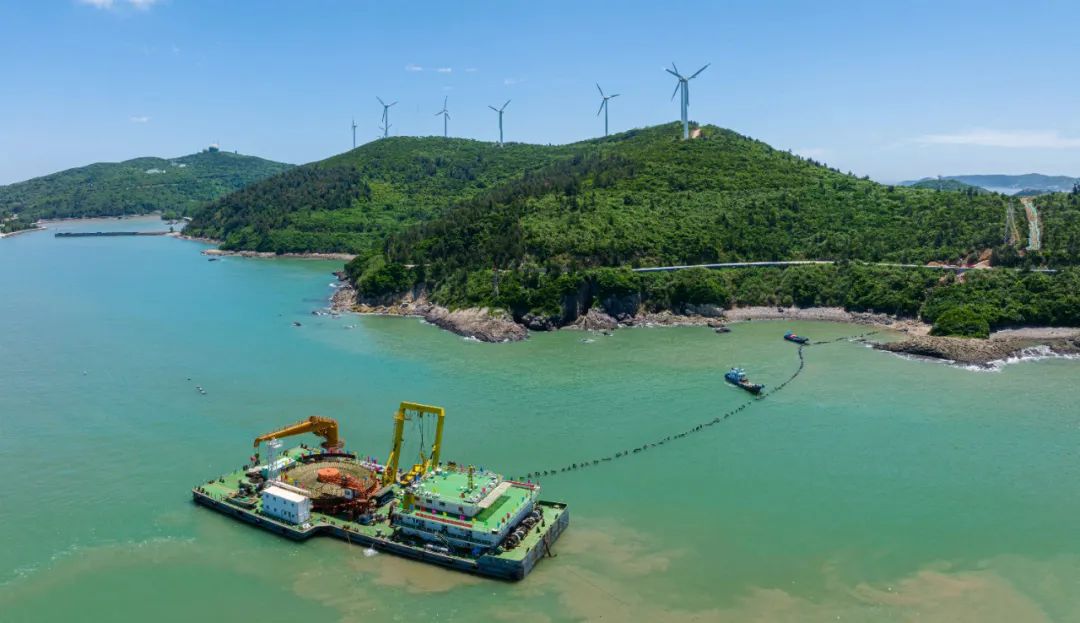The world's first "electric dragon" into the sea! CCTV Live: China's First Flexible Low-Frequency Transmission Demonstration Project
May 29, 2024, 11:58 AM
TDD-global
6384
Early in the morning, CCTV reporters came to the submarine cable laying site - a submarine cable laying ship 4 kilometers away from Jinqing Town, Taizhou City, Zhejiang Province. On the surface of the East China Sea, with the help of the submarine cable electric turntable and the high-pressure water pump, the low-frequency submarine cable is like an "electric dragon", slowly entering the preset channel 3 meters deep under the sea at a speed of 5 meters per minute.
Early in the morning, CCTV reporters came to the submarine cable laying site - a submarine cable laying ship 4 kilometers away from Jinqing Town, Taizhou City, Zhejiang Province. On the surface of the East China Sea, with the help of the submarine cable electric turntable and the high-pressure water pump, the low-frequency submarine cable is like an "electric dragon", slowly entering the preset channel 3 meters deep under the sea at a speed of 5 meters per minute.
The world's first low-frequency submarine cable connects Dachen Island in Taizhou City, Zhejiang Province and Jinqing Town in Luqiao District, Taizhou, with a total length of 27 kilometers. According to the weather conditions, the laying of the low-frequency submarine cable will be completed on the 13th, laying a solid foundation for the scheduled commissioning of the Taizhou flexible low-frequency power transmission demonstration project in June.
The Taizhou Flexible Low-Frequency Transmission Demonstration Project pioneered the low-frequency interconnection technology for islands, and combined the low-frequency access technology of wind turbines to build a land-island-wind power interconnection system to verify the feasibility of the low-frequency direct transmission technology of low-frequency wind turbines via submarine cables, and to develop 35kV flexible AC frequency conversion station, low frequency transformer, low frequency circuit breaker, low frequency fan, low frequency control and protection system and low frequency meter and many other first sets of equipment. The project has a positive role in promoting the construction of a "zero carbon island" in Dachen Island and creating a model for a common prosperity island.
Energy China Zhejiang Institute undertook the construction of a new 35kV frequency conversion station for the Taizhou Flexible Low Frequency Transmission Demonstration Project, the expansion of the low-frequency power distribution device at the 35kV Dachen Substation, and the newly built Dachen Substation-Yanchang Frequency Conversion Station 35kV submarine cable line And the design of supporting lines.
The relevant technologies of this demonstration project can be applied to scenarios such as efficient transmission of mid-to-long-distance offshore wind power, onshore new energy collection and transmission, multi-island interconnection and cable-based urban grid power supply, and long-distance power transmission in remote areas. It is also an important exploration for high-quality realization of the "dual carbon" goal.

What is the low-frequency transmission of energy, and where is the creativity reflected?
At this stage, the main ways to improve the power transmission capacity of the line are to increase the voltage level or use DC power transmission, but few people have explored to improve the power transmission capacity through the frequency dimension.
Flexible low-frequency power transmission is a new type of high-efficiency AC power transmission technology based on fully controlled power electronic devices. It reduces the 50Hz power frequency to about 20Hz low frequency through a high-voltage large-capacity AC converter, reduces line impedance, and reduces cable line charging. Reactive power, by exploiting the potential of the frequency dimension, realizes the improvement of system power transmission capability and flexible regulation capability.
For example, comparing the low-frequency power transmission technology with the power-frequency power transmission technology is like having a water pipe with a larger capacity and a wider diameter at the same cost. The water source can be transported more, and the same is true of electric energy. Dachen Island is currently delivering a maximum of 600,000 kWh of electricity to the mainland every day, and it will reach 800,000 kWh or even 1 million kWh in the future.
The world's first low-frequency submarine cable connects Dachen Island in Taizhou City, Zhejiang Province and Jinqing Town in Luqiao District, Taizhou, with a total length of 27 kilometers. According to the weather conditions, the laying of the low-frequency submarine cable will be completed on the 13th, laying a solid foundation for the scheduled commissioning of the Taizhou flexible low-frequency power transmission demonstration project in June.
The Taizhou Flexible Low-Frequency Transmission Demonstration Project pioneered the low-frequency interconnection technology for islands, and combined the low-frequency access technology of wind turbines to build a land-island-wind power interconnection system to verify the feasibility of the low-frequency direct transmission technology of low-frequency wind turbines via submarine cables, and to develop 35kV flexible AC frequency conversion station, low frequency transformer, low frequency circuit breaker, low frequency fan, low frequency control and protection system and low frequency meter and many other first sets of equipment. The project has a positive role in promoting the construction of a "zero carbon island" in Dachen Island and creating a model for a common prosperity island.
Energy China Zhejiang Institute undertook the construction of a new 35kV frequency conversion station for the Taizhou Flexible Low Frequency Transmission Demonstration Project, the expansion of the low-frequency power distribution device at the 35kV Dachen Substation, and the newly built Dachen Substation-Yanchang Frequency Conversion Station 35kV submarine cable line And the design of supporting lines.
The relevant technologies of this demonstration project can be applied to scenarios such as efficient transmission of mid-to-long-distance offshore wind power, onshore new energy collection and transmission, multi-island interconnection and cable-based urban grid power supply, and long-distance power transmission in remote areas. It is also an important exploration for high-quality realization of the "dual carbon" goal.

What is the low-frequency transmission of energy, and where is the creativity reflected?
At this stage, the main ways to improve the power transmission capacity of the line are to increase the voltage level or use DC power transmission, but few people have explored to improve the power transmission capacity through the frequency dimension.
Flexible low-frequency power transmission is a new type of high-efficiency AC power transmission technology based on fully controlled power electronic devices. It reduces the 50Hz power frequency to about 20Hz low frequency through a high-voltage large-capacity AC converter, reduces line impedance, and reduces cable line charging. Reactive power, by exploiting the potential of the frequency dimension, realizes the improvement of system power transmission capability and flexible regulation capability.
For example, comparing the low-frequency power transmission technology with the power-frequency power transmission technology is like having a water pipe with a larger capacity and a wider diameter at the same cost. The water source can be transported more, and the same is true of electric energy. Dachen Island is currently delivering a maximum of 600,000 kWh of electricity to the mainland every day, and it will reach 800,000 kWh or even 1 million kWh in the future.
August 21, 2024, 2:42 PM
August 21, 2024, 2:28 PM
August 21, 2024, 2:52 PM
August 21, 2024, 2:20 PM













